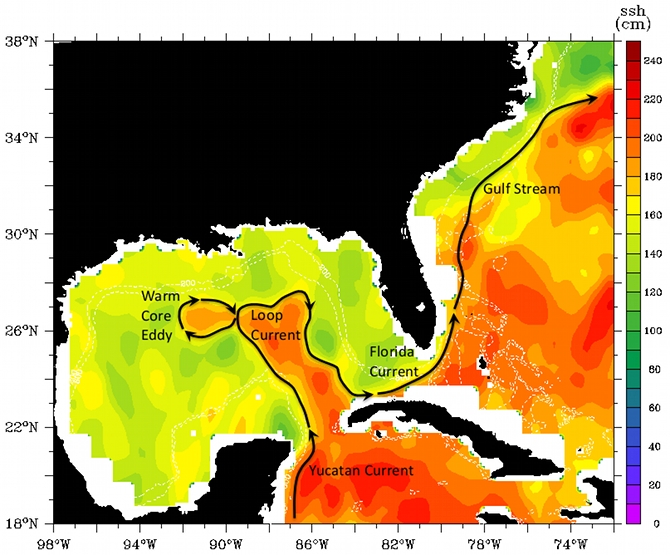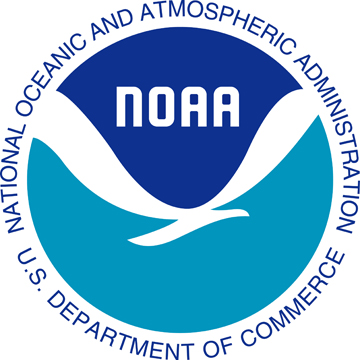
|
Hurricane and Loop Current research at the Upper Ocean Dynamics Laboratory is generously supported through the following funding agencies:
|
|
Research Projects
Mixed layer cooling response of geostrophic oceanic eddies to
tropical cyclone forcing
Upper-ocean thermal structures encountered by tropical cyclones (TC) are seldom uniform. These storms usually move over energetic, deep-warm western boundary currents, warm and cold core geostrophic eddies (WCEs and CCEs, respectively, Figure 1), where horizontal thermal gradients tighten over distances of O(10) km. The presence of geostrophic oceanic features has been shown to impact the efficiency of TCs to cool the oceanic mixed layer (OML), modulating sea surface temperature (SST) cooling and the ensuing air-sea fluxes into the TC (i.e. negative feedback). In warm oceanic geostrophic features OMLs are deep, and the associated ocean heat content values relative to the 26oC isotherm depth often exceed 100 kJ cm-2. Reduced OML cooling response has been observed in these warm features, thereby providing a sustained heat flux that, under neutral to favorable atmospheric conditions (e.g., weak atmospheric shear), contributes to rapid TC intensification. Numerical models have reproduced this positive impact of high oceanic heat content and reduced cooling on TC intensification. By contrast, shallow OMLs, less ocean heat content, and more vigorous OML cooling response in CCEs may contribute to rapid TC weakening. Understanding this contrasting OML thermal response of geostrophic oceanic features to wind stress forcing is thus important for predicting accurate TC intensity changes in coupled numerical models.

|
Figure 1. (a) Distribution of all tropical cyclone trajectories on record (hurricane intensity level), from the National Hurricane Center and Joint Typhoon Warning Center databases; trajectory segments with higher storm intensity level are on top. (b) Typical global distribution of sea surface height anomaly (SHA), from a daily composite of the AVISO product. Blue (red) shades are for cyclonic (anticyclonic) ocean eddies (CCEs and WCEs, respectively); contours are for SHA=±15 cm (Jaimes et al. 2011).
More on this topic:
Jaimes, B., and L. K. Shay, 2009: Mixed layer cooling in mesoscale oceanic eddies during hurricanes Katrina and Rita.
Mon. Wea. Rev., 137, 4188-4207. Abstract
Jaimes, B., L. K. Shay, and G. R. Halliwell, 2011: The response of quasigeostrophic oceanic vortices to tropical cyclone forcing.
J. Phys. Oceanogr., 41, 1965-1985. Abstract
Animations of OML cooling response of quasi-geostrophic vortices to tropical cyclone forcing
Near-inertial waves in geostrophic flow
Kinetic energy spectra in the ocean generally present a dominant energy peak at
frequencies near the local Coriolis frequency ( f ) . Compared with the rest of the internal
wave spectrum, which is remarkable constant (Garrett and Munk 1972), this 'near-inertial'
peak changes in time and space, and is broad. This near-inertial passband is
important because it contains most of the shear in the ocean (Garrett 2001), and this shear
impacts the global climate by producing much of the diapycnal mixing needed to
maintain the Meridional Overturning Circulation (Alford 2003; Wunsch and Ferrari
2004); this mixing affects the dispersion of pollutants, larvae, and nutrients in the water
column. Understanding the processes that control the intermittence and broadening of this
energetic part of the internal wave spectrum is therefore important to improve our
assessment of mixing events in the ocean.
Observational evidence, linear theory, and numerical models indicate that the presence of geostrophic oceanic vortices
clearly modulates vertical dispersion of
OML near-inertial energy (e.g. Figure 2). Near-inertial oscillations are shifted toward more subinertial
and energetic frequencies inside WCEs, where rapid vertical dispersion prevents
accumulation of kinetic energy and momentum in the upper ocean, thereby reducing
vertical shear development and entrainment at the layer base. By contrast, near-inertial
oscillations are dampened in OMLs of CCEs that enhances vertical shear and mixing at
the layer base. This has important implications for accurate intensity forecasting in hurricane coupled models;
numerical models that neglect ocenic geostrophic features can
significantly underestimate or overestimate OML cooling, because they fail to accurately
represent OML near-inertial energy decay, which affects the amount of kinetic energy
available for vertical entrainment at the layer base.

|
Figure 2. Near-inertial wave ray-tracing based on Kunze's (1985) model, for (a) Katrina and (b) Rita. The numbers along the wave rays indicate inertial periods (one inertial period is ~25.5 hr), dots are hourly positions, color is the ray's depth level, and the flow lines are from geostrophic flow fields derived from (a) post Katrina (15 September) and (b) post Rita (26 September) airborne-based data. The gray shades represent regions where horizontal strain is small (Jaimes and Shay 2010).
Near-inertial wave propagation in quasi-geostrophic vortices has a significant impact on vertical mixing over the OML and thermocline, and affects the leakage of near-inertial kinetic energy into the deep ocean. As the vortex's rotational rate is increased, near-inertial shear is accentuated thus enhancing vertical mixing over the upper ocean in CCEs and WCEs (Figure 3). Consequently, more near-inertial energy will be used for vertical mixing in upper layers of quasi-geostrophic vortices, and less near-inertial energy will be available for the diapycnal mixing at greater depth that is required to maintain the Meridional Overturning Circulation. This result is consistent with recent estimates of the contribution of wind-induced near-inertial energy to mixing at deep waters (Jaimes and Shay 2009, 2010; Zhai et al. 2009).

|
Figure 3. Numerical simulation of OML cooling (dT) as a function of the Rossby number (Ro), after 3 inertial periods in WCEs (upper panels) and CCEs (lower panels) for the same tropical cyclone wind forcing. (a, b) Ro=0.06, and (c, d) Ro=0.08. The OML turbulence closure consideres vertical mixing by instantaneous wind stirring, and turbulence generation by vertical shear instability at the OML base and over the stratified ocean below (Jaimes et al. 2011).
More on this topic:
Jaimes, B., and L. K. Shay, 2010: Near-inertial wave wake of hurricanes Katrina and Rita over mesoscale oceanic eddies.
J. Phys. Oceanogr., 40, 1320-1337.
Abstract
TOP
Dynamics of the Gulf of Mexico and Loop Current
The Gulf of Mexico (GOM) is a semi-enclosed sea, which connects with the Caribbean
Sea through the Yucatan Channel and with the North Atlantic Ocean through the Florida
Straits. The circulation in the basin is forced at the sea surface by wind stress (and in less degree by heat and
freshwater fluxes), and at the Yucatan Channel by the North Atlantic Western Boundary Current System (NAWBCS),
where most of the Sverdrup type transport of the North Atlantic Subtropical Gyre merges with the Meridional
Overturning Circulation (Schmitz and Richardson 1991), yielding a net average flux
of 23.8±1 Sv (Sheinbaum et al. 2002).
The baroclinic structure of the NAWBCS within the Channel consists of the Yucatan
Current flowing into the Gulf of Mexico in upper western layers, the southerly Yucatan
Counter-current beneath it, and two southerly jets on the Cuban side, one at surface and
another at depth (Sheinbaum et al. 2002). In surface waters (upper 800-900 m) the Yucatan
Current spreads over the southeastern Gulf, forming an anticyclonic-looping and pulsating
circulation: the Loop Current (LC), the regional component of the NAWBCS and principal
current within the Gulf of Mexico. The LC leaves the basin across the Florida Straits,
becoming the Florida Current and the Gulf Stream (Figure 4).
The transport through the Yucatan Channel has historically been recognized as the
dominant mechanism driving the circulation in the Gulf. Hurlburt and Thompson (1980)
conducted a series of idealized numerical experiments and showed that even a prescribed
steady transport at the Channel, used as the only forcing, is able to
produce the distinctive circulation features observed in the basin, including a realistic LC
cycle, consisting of an extensive northwestward intrusion followed by the shedding
of an anticyclonic mesoscale vortex (LC ring, or WCE), and the return to the so
called port-to-port configuration (direct path from the Yucatan Channel to the Florida
Straits). However, the shedding exhibited an unrealistic quasi-annual regularity. In reality
the LC cycle is strongly variable, with recurrent shedding events at peak periods from 6 to 11
months, and frequent ring detachments and reattachments during the separation sequence (Sturges and Leben 2000).

|
Figure 4. Major ocean currents in and around the Gulf of Mexico.
The LC cycle has been observed to influence surface flows in the Gulf of Mexico, including the anticyclonic circulation associated with the LC northwest-ward extension in the eastern Gulf, and the anticyclonic circulation in the western region where the LC WCEs decay. Over the latter region, the LC eddies compete with the wind in driving the Western Boundary Current along the Mexican shelf and the Bay of Campeche Cyclone. By means of vortex stretching and Reynolds stress, LC processes influence intermediate and deep waters. That is, planetary and topographic Rossby waves, together with other mesoscale transient vortices (westward-propagating LC WCEs, modons, and cyclones) represent the low-frequency, LC-driven eddy variability produced during an adjustment process. One of my scientific interests considers the nature of formation and separation of LC WCEs, the role of LC eddies (vortex- or wave-like) in driving regional mean flows (inverse energy cascade), the role of the LC in the Gulf of Mexico's energy cycle, and the relative contribution of the wind to this energy cycle.
More on this topic:
Jaimes, B., 2005: Energetics of the wind and Loop Current-driven circulation in the Gulf of Mexico. M.S. thesis, University of Miami, 128 pp.
PDF
On the remotely Loop Current-driven western boundary current in the Gulf of Mexico (work in progress).
The shedding of Loop Current warm core eddy Franklin (work in progress).
References
Alford, M. H., 2003: Redistribution of energy available for ocean mixing by long-range propagation of internal waves. Nature, 423:159-162.
Garrett, C., 2001: What is the "near-inertial" band and why is it different from the rest of the internal wave spectrum? J. Phys. Oceanogr., 31, 962-71.
Garrett, C. J. R., and W. H. Munk, 1972: Space-time scales of internal waves. Geophys. Fluid Dyn., 2, 225-264.
Hurlburt, H.E., and J.D. Thompson, 1980: A numerical study of Loop Current intrusion and eddy shedding. J. Phys. Oceanogr., 10, 1611-1651.
Jaimes, B., L. K. Shay, and G. R. Halliwell, 2011: The response of quasigeostrophic oceanic vortices to tropical cyclone forcing. J. Phys. Oceanogr., 41, 1965-1985. Abstract
Jaimes, B., and L. K. Shay, 2010: Near-inertial wave wake of hurricanes Katrina and Rita over mesoscale oceanic eddies. J. Phys. Oceanogr., 40, 1320-1337. Abstract
Jaimes, B., and L. K. Shay, 2009: Mixed layer cooling in mesoscale oceanic eddies during hurricanes Katrina and Rita. Mon. Wea. Rev., 137, 4188-4207. Abstract
Kunze, E., 1985: Near-inertial wave propagation in geostrophic shear. J. Phys. Oceanogr., 15, 544-565.
Schmitz, W.J., Jr., and P.L. Richardson, 1991: On the sources of the Florida Current. Deep Sea Res., Part A, 38, supp. 1, S379-S409.
Sheinbaum, J., J. Candela, A. Badan, and J. Ochoa, 2002: Flow structure and transport in the Yucatan Channel. Geophys. Res. Let., 29(3), doi:10.1029/2001GL013990.
Sturges, W., and R. Leben, 2000: Frequency of ring separations from the Loop Current in the Gulf of Mexico: A revised estimate. J. Phys. Oceanogr., 30(7), 1814-1819.
Wunsch, C., and R. Ferrari, 2004: Vertical mixing, energy, and the general circulation of the oceans. Ann. Rev. Fluid Mech., Vol. 36, 281-314.
Zhai, X., R. J. Greatbatch, C. Eden, and T. Hibiya, 2009: On the loss of wind-induced near-inertial energy to turbulent mixing in the upper ocean. J. Phys. Oceanogr., 39, 3040-3045.
TOP








